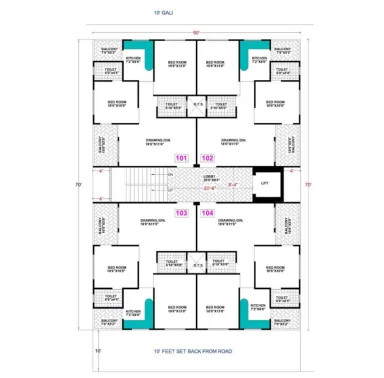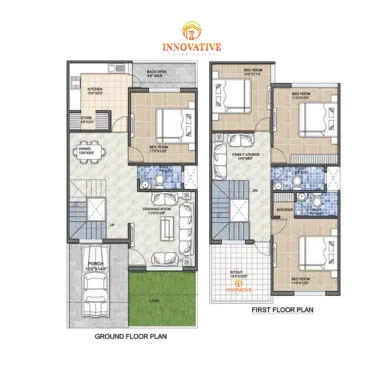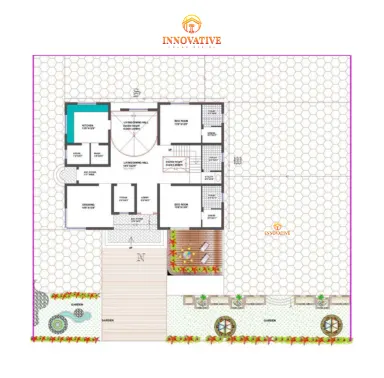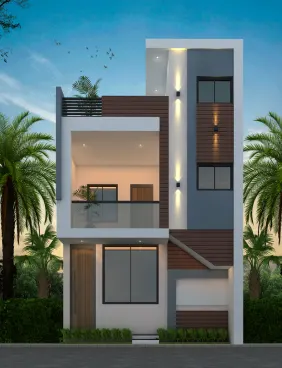 05 Agust 2025
05 Agust 2025  Admin
Admin
How to Choose the Perfect Floor Plan for Your Dream Home
Building a dream home is one of the biggest milestones in life. From picking the right plot to choosing colors and interiors, every decision matters. But one of the most important steps that decides the look and comfort of your home is the floor plan.
A floor plan is basically the map of your home — it shows how rooms, doors, windows, and spaces will be arranged. If the floor plan is right, your home will feel spacious, comfortable, and practical. But if it is wrong, you may face problems later that are costly and difficult to fix.
In this blog, let’s look at how to choose the perfect floor plan for your dream home in simple steps.
Understand Your Family’s Needs
Every family is different, and so are their requirements. Before finalizing a floor plan, think about how many members will live in the house and what their needs are.
- A young couple might want an open floor plan with stylish interiors.
- A family with kids may need extra bedrooms, a play area, or more storage space.
- A joint family might need multiple floors or separate living areas for privacy.
List down your “must-have” features like the number of bedrooms, bathrooms, size of the kitchen, or parking space. This will help you avoid confusion later.
Decide the Number of Floors
Do you want a single-story house or a multi-story home?
- Single-story homes are easier to maintain and good for families with elderly members or small children.
- Multi-story homes (duplex, triplex, etc.) give you more space on a smaller plot and can separate private areas (like bedrooms upstairs) from public ones (like living and dining on the ground floor).
Think about your lifestyle and future needs before deciding.
Think About the Plot Size and Shape
The size and shape of your land plays a big role in the floor plan. For example:
- A 30x40 ft plot may need a compact floor plan with smart space-saving ideas.
- A 50x60 ft plotgives you the freedom to add bigger rooms, parking space, or even a garden.
Always discuss with your architect to make the best use of your plot without wasting any space.
Focus on the Living Area
The living room is usually the first impression of your home. It’s also where families spend the most time together. Make sure the floor plan has enough space for a comfortable seating arrangement, proper ventilation, and natural light.
If you prefer hosting guests, go for a spacious living room that connects well with the dining and kitchen areas.
Plan the Kitchen Wisely
The kitchen is the heart of the home, and its design affects your daily life. Decide whether you want a closed kitchen for privacy or an open kitchen connected to the dining area.
Modern families often prefer modular kitchens with smart storage, but the shape matters too: L-shaped, U-shaped, or straight-line layouts each have their own benefits.
Don’t Forget Storage Spaces
One mistake people often make is ignoring storage needs. Later, they end up with cluttered rooms. A good floor plan always includes proper storage: wardrobes, cabinets, lofts, or even a storeroom.
Think about where you will keep your seasonal clothes, appliances, or household items. Smart storage makes life easier and keeps the home neat.
Check the Flow of Movement
Imagine walking through the house. Is it easy to move from one room to another? Or do you have to cross bedrooms to reach the kitchen?
A perfect floor plan has a smooth flow — bedrooms in private corners, living areas in the center, and easy access to bathrooms. This makes the home practical and comfortable for daily use.
Consider Natural Light and Ventilation
A house full of natural light feels lively and saves energy. While choosing a floor plan, make sure there are enough windows, balconies, and open areas for sunlight and fresh air.
Cross-ventilation is very important, especially in Indian climates. Large windows facing east or north bring in maximum daylight without heating up the home.
Think of the Future
A home is not built for just today, but for many years. Ask yourself:
- Will your family grow in the future?
- Do you need a guest room for relatives?
- Do you plan to work from home and need a home office?
Choosing a flexible floor plan that can adjust to your future lifestyle is a smart move.
Follow Vastu Guidelines (If You Believe In It)
Many Indian families prefer Vastu-compliant homes for positivity and balance. Simple things like placing the kitchen in the southeast or the main door facing east can be adjusted during floor planning. Even if you are not a firm believer, aligning with Vastu may improve your home’s resale value.
Check Your Budget
While it’s tempting to go for a big, stylish house, always keep your budget in mind. Every extra room, staircase, or bathroom adds to construction costs. Discuss with your architect and find a balance between your dream design and your budget.
Consult an Expert
Finally, always get professional advice like Innovative House Design. An experienced architect or interior designer can guide you with creative ideas, energy-saving tips, and smart use of space. They can also make 3D plans to help you visualize the house before construction begins.
Conclusion
Choosing the right floor plan is like laying the foundation of your dream home. A thoughtful design makes life comfortable, adds beauty to your home, and ensures that the house grows with your family.
Think about your lifestyle, budget, and future needs before finalizing. Remember — walls can be painted later, furniture can be replaced, but the floor plan stays forever.
So take your time, plan carefully, and create a home that not only looks beautiful but also feels like the perfect fit for your family.












